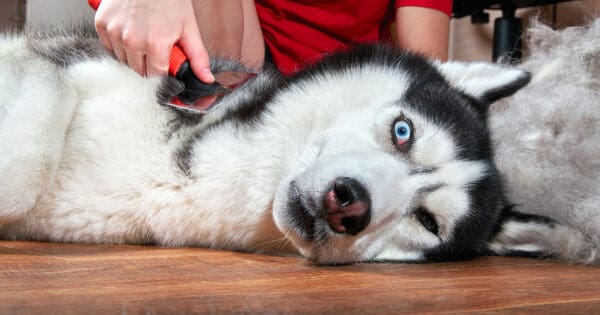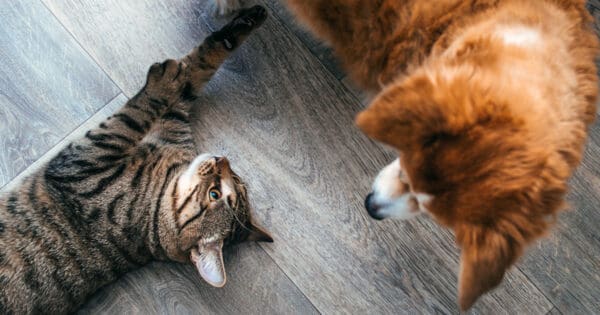
11401 NE 195th St. Bothell, WA 98011
(425) 486-9000 PHONE (425) 486-9002 fax
Notice: Below care sheet is from 2016, and may not reflect up-to-date care information.
Quick facts
- Average life span: 8–14 yrs
- Age of reproductive maturity: doe 4–9 months, buck 6–10 months
- Average litter size: 4–10 kits (baby rabbits are called kits or kittens)
- Gestation length: 29–35 days
- All teeth (both incisors and back teeth) continually grow at a rate of ~0.3 mm per day
- Cecotrophs are feces that are excreted overnight and contain many nutrients that rabbits require in their diet. These feces are generally ingested by the rabbit directly from the rectum in the early morning.
Enclosure
Ideally, rabbits should be housed primarily indoors. There are many outdoor rabbits that are hurt or killed each year from predator attacks through what appeared to be safe hutches. Outdoor rabbits are also prone to heat stroke and a variety of parasite infections that are largely preventable through indoor housing.
Provide the largest enclosure possible for your pet rabbit. Cages should have a solid floor area to help prevent pressure sores from developing on the feet. Hay should always be available for the rabbit to munch on, and interactive toys should be provided to help prevent boredom.
If possible, house rabbits should be allowed regular, supervised outdoor access in grassy areas that are not treated with fertilizers or pesticides for grazing purposes. This is a natural behavior that is very enriching for them. However, it is important to note that allowing your rabbit to graze outdoors may expose him/her to certain diseases, predators, and other dangers. Ideally, a protective “grazing ark” should be used to help keep your rabbit safe during these outings. It is very important to always supervise your rabbit while he/she is grazing, and to minimize exposure to wildlife.
Substrate/bedding
Ideal substrates include any of the paper based products (i.e. Carefresh and similar products). Towels or fleece blankets may also be used, but need to be regularly checked to make sure the rabbit is not ingesting any of the material. Hay can also make an excellent bedding material.
Litter Box Training
Start with a small area, pick a corner where rabbit has already used, and add a litter box to that corner. Recycled paper litters should be used. Wood shavings are not advised, as they are indigestible. Add a small amount of hay on top of litter to entice the rabbit to sit in the litter box. Spaying or neutering rabbits will make them more likely to use the litter box.
REMEMBER: Rabbits are not cats, and are not likely to use their litter box 100% of the time.
Diet
Under 6 months of age:
- Free choice of alfalfa hay (may add timothy hay as well)
- Free choice of alfalfa-based rabbit pellets. These pellets SHOULD NOT have any oats, seeds or dried fruits/vegetables added to the mix.
6 months and older:
- Free choice of timothy hay, orchard grass hay, brome hay, meadow hay, and/or oat hay. Ideally, you should rotate types of hay offered. No alfalfa hay should be given unless the rabbit is pregnant or lactating. Oxbow Hay Company (1-800-249-0366, www.oxbowhay.com) produces high quality hays for rabbits.
- Timothy hay based rabbit pellets (no oats, seeds, or dried fruits/vegetables included in the mix): 1 tablespoon per kilogram (approximately 1 tablespoon/2 lbs)
- Green leafy vegetables and herbs (the darker the green, the higher the nutritional value):
- 1/2 cup/day for large rabbits (9-12 lbs)
- 1/3 to 1/4 cup/day for smaller rabbits
- Examples: kale, romaine lettuce, escarole, parsley, endive, collard greens, dandelion greens, leaf lettuce, carrot/beet tops, water cress, mustard greens, bok choy, chicory, basil, carrots, turnips, beets, & sweet potatoes.
Fresh water should be provided at all times. If water bottles are used, they need to be checked daily for malfunctions.
Natural wood branches are great for rabbits to chew on. We recommend using apple, pear, willow, or maple. To sterilize the wood and prevent parasite infection, clean the branch with soap and water, then bake it in the oven for 50 minutes at 250 degrees. Never use oak, pine, or cherry wood (All are potentially toxic to rabbits).
Fruit can be given as a rare treat (apple, orange, banana, pineapple, etc.). Limit to a tablespoon per 2 lbs. of body weight per day or less. Commercial treats made by Oxbow are also available, and can be fed in small amounts (<5% of the total diet).
Exercise
Rabbits need plenty of time out of their cage daily to provide exercise. Lack of exercise can lead to numerous medical and/or behavioral problems.
Behavior
Rabbits are very social animals, and often do best when kept in spayed/neutered pairs. Well socialized rabbits are usually inquisitive, and seek out human interaction whenever possible. Not all rabbits enjoy being picked up and cuddled, however. Rabbits can be trained to do tricks using positive reinforcement training methods.
Schedule of Veterinary Care
- Bi-annual physical exam
- spay/neuter at 3-6 months of age
- nail trims as needed
- Ask for information on our discounted CLAW wellness plans!
Why Should I Spay or Neuter My Rabbit?
Spaying or neutering your rabbit will prevent unwanted litters. Female rabbits also have a high rate of reproductive tumors, which can be virtually eliminated with spaying under a year of age. Many reproductively intact rabbits develop undesirable behavior patterns, such as aggression and urine spraying.
Common Medical Problems
- Reproductive tract cancer in female rabbits: Very common in middle aged, unspayed female rabbits. This cancer is completely preventable by spaying your rabbit at a young age.
- Overgrown teeth: Extremely common. May be caused by dental malalignment, improper diet, or infections.
- Ileus (GI stasis): Decreased production of normal fecal pellets. This can be caused by stress, improper diet, dental disease, consumption of indigestible fibers (i.e. carpet or towels), infections, and many other health problems.
- Diarrhea: True diarrhea is uncommon. Intermittent soft stools (cecotrophs) are normal (cecotrophs will commonly be produced at night and eaten by your rabbit; firm stools are produced during the day). Sudden diet change or low fiber diets may cause diarrhea.
- Pasteurellosis (“Snuffles”): runny nose, decreased appetite/activity, and abnormal head posture are common symptoms.
- Ear infections: This is primarily a problem in lop rabbits, due to poor air circulation within the ear.
- Head tilt: This can be caused by many different health problems, including: inner ear infections, Encephalitozoon cuniculi (protozoan parasite) infection, cancer, parasitic migration in the brain (i.e. Baylisascaris), and brain abscesses.
- Fur mites: external parasites that cause excessive hair loss, dandruff, and severe itching
- Pododermitis (“Bumblefoot”): Pressure sores (usually on the bottom of the back feet) from inactivity, improper flooring, obesity, or trauma.
March 30, 2015
Content of this Care Sheet Courtesy of:
The Center for Bird and Exotic Animal Medicine
11401 NE 195th St. Bothell, WA 98011
(425) 486-9000 PHONE (425) 486-9002 fax



